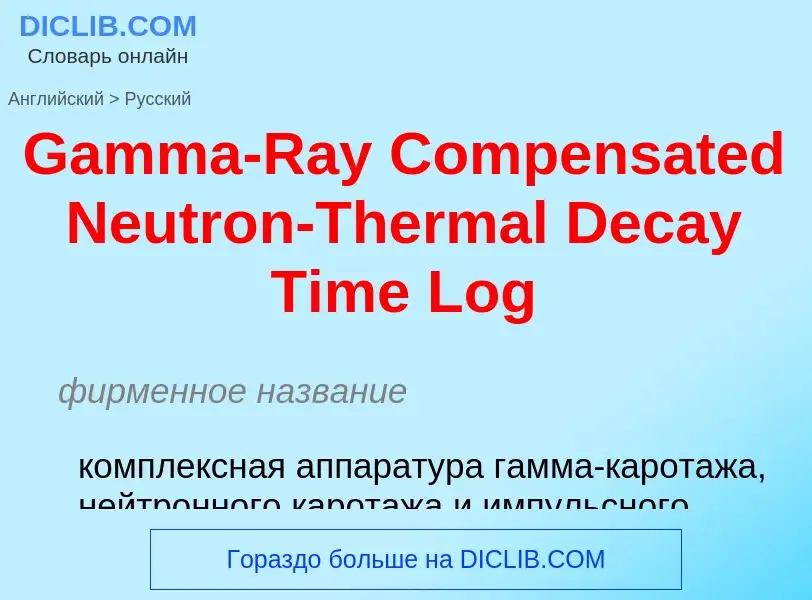Перевод и анализ слов искусственным интеллектом ChatGPT
На этой странице Вы можете получить подробный анализ слова или словосочетания, произведенный с помощью лучшей на сегодняшний день технологии искусственного интеллекта:
- как употребляется слово
- частота употребления
- используется оно чаще в устной или письменной речи
- варианты перевода слова
- примеры употребления (несколько фраз с переводом)
- этимология
Gamma-Ray Compensated Neutron-Thermal Decay Time Log - перевод на русский
фирменное название
комплексная аппаратура гамма-каротажа, нейтронного каротажа и импульсного нейтронного каротажа
[gæmədi'kei]
физика
гамма-распад
физика
гамма-установка
Определение
---
в музыке - звукоряд - последование всех звуков лада, расположенных от основного тона в восходящем или нисходящем порядке; имеет объем октавы, но может быть продолжена в соседние октавы. См. также Хроматическая гамма.
---
(обозначается ?) , 1) стотысячная доля эрстеда, 1 ? = 10-5 Э. 2) Редко применяемая дольная единица массы, 1 ? = 10-9 кг, чаще называют микрограммом (мкг).
Википедия
Gamma ray logging is a method of measuring naturally occurring gamma radiation to characterize the rock or sediment in a borehole or drill hole. It is a wireline logging method used in mining, mineral exploration, water-well drilling, for formation evaluation in oil and gas well drilling and for other related purposes. Different types of rock emit different amounts and different spectra of natural gamma radiation. In particular, shales usually emit more gamma rays than other sedimentary rocks, such as sandstone, gypsum, salt, coal, dolomite, or limestone because radioactive potassium is a common component in their clay content, and because the cation-exchange capacity of clay causes them to absorb uranium and thorium. This difference in radioactivity between shales and sandstones/carbonate rocks allows the gamma ray tool to distinguish between shales and non-shales. But it cannot distinguish between carbonates and sandstone as they both have similar deflections on the gamma ray log. Thus gamma ray logs cannot be said to make good lithological logs by themselves, but in practice, gamma ray logs are compared side-by-side with stratigraphic logs.
The gamma ray log, like other types of well logging, is done by lowering an instrument down the drill hole and recording gamma radiation variation with depth. In the United States, the device most commonly records measurements at 1/2-foot intervals. Gamma radiation is usually recorded in API units, a measurement originated by the petroleum industry. Gamma rays attenuate according to the diameter of the borehole mainly because of the properties of the fluid filling the borehole, but because gamma logs are generally used in a qualitative way, amplitude corrections are usually not necessary.
Three elements and their decay chains are responsible for the radiation emitted by rock: potassium, thorium and uranium. Shales often contain potassium as part of their clay content and tend to absorb uranium and thorium as well. A common gamma-ray log records the total radiation and cannot distinguish between the radioactive elements, while a spectral gamma ray log (see below) can.
For standard gamma-ray logs, the measured value of gamma-ray radiation is calculated from concentration of uranium in ppm, thorium in ppm, and potassium in weight percent: e.g., GR API = 8 × uranium concentration in ppm + 4 × thorium concentration in ppm + 16 × potassium concentration in weight percent. Due to the weighted nature of uranium concentration in the GR API calculation, anomalous concentrations of uranium can cause clean sand reservoirs to appear shaley. For this reason, spectral gamma ray is used to provide an individual reading for each element so that anomalous concentrations can be found and properly interpreted.
An advantage of the gamma log over some other types of well logs is that it works through the steel and cement walls of cased boreholes. Although concrete and steel absorb some of the gamma radiation, enough travels through the steel and cement to allow for qualitative determinations.
In some places, non-shales exhibit elevated levels of gamma radiation. For instance, sandstones can contain uranium minerals, potassium feldspar, clay filling, or lithic fragments that cause the rock to have higher than usual gamma readings. Coal and dolomite may contain absorbed uranium. Evaporite deposits may contain potassium minerals such as sylvite and carnallite. When this is the case, spectral gamma ray logging should be done to identify the source of these anomalies.


![Image of entire sky in 100 MeV or greater gamma rays as seen by the EGRET instrument aboard the [[CGRO]] spacecraft. Bright spots within the galactic plane are [[pulsar]]s while those above and below the plane are thought to be [[quasar]]s. Image of entire sky in 100 MeV or greater gamma rays as seen by the EGRET instrument aboard the [[CGRO]] spacecraft. Bright spots within the galactic plane are [[pulsar]]s while those above and below the plane are thought to be [[quasar]]s.](https://commons.wikimedia.org/wiki/Special:FilePath/Egret all sky gamma ray map from CGRO spacecraft.png?width=200)
![A [[hypernova]]. Artist's illustration showing the life of a [[massive star]] as [[nuclear fusion]] converts lighter elements into heavier ones. When fusion no longer generates enough pressure to counteract gravity, the star rapidly collapses to form a [[black hole]]. Theoretically, energy may be released during the collapse along the axis of rotation to form a long duration [[gamma-ray burst]]. A [[hypernova]]. Artist's illustration showing the life of a [[massive star]] as [[nuclear fusion]] converts lighter elements into heavier ones. When fusion no longer generates enough pressure to counteract gravity, the star rapidly collapses to form a [[black hole]]. Theoretically, energy may be released during the collapse along the axis of rotation to form a long duration [[gamma-ray burst]].](https://commons.wikimedia.org/wiki/Special:FilePath/Gamma ray burst.jpg?width=200)

